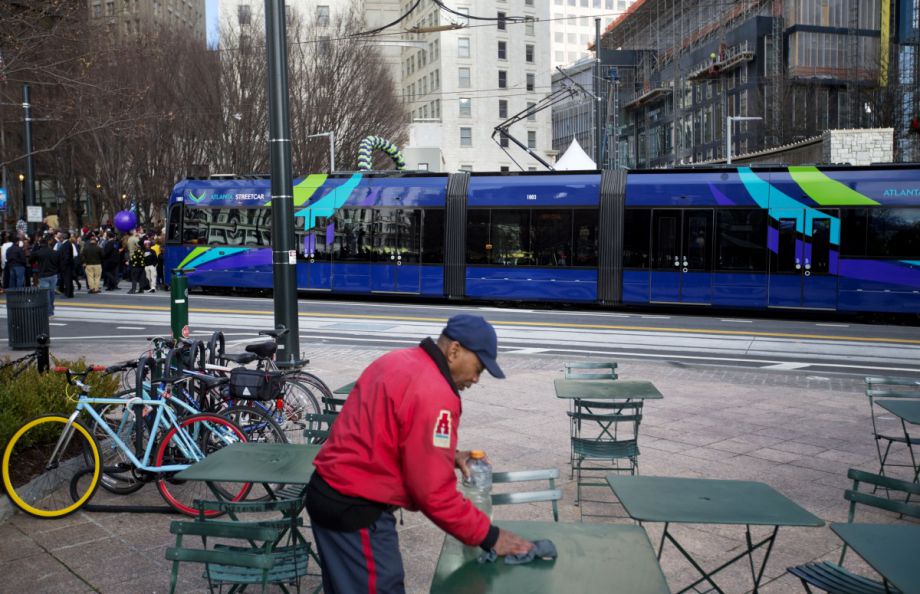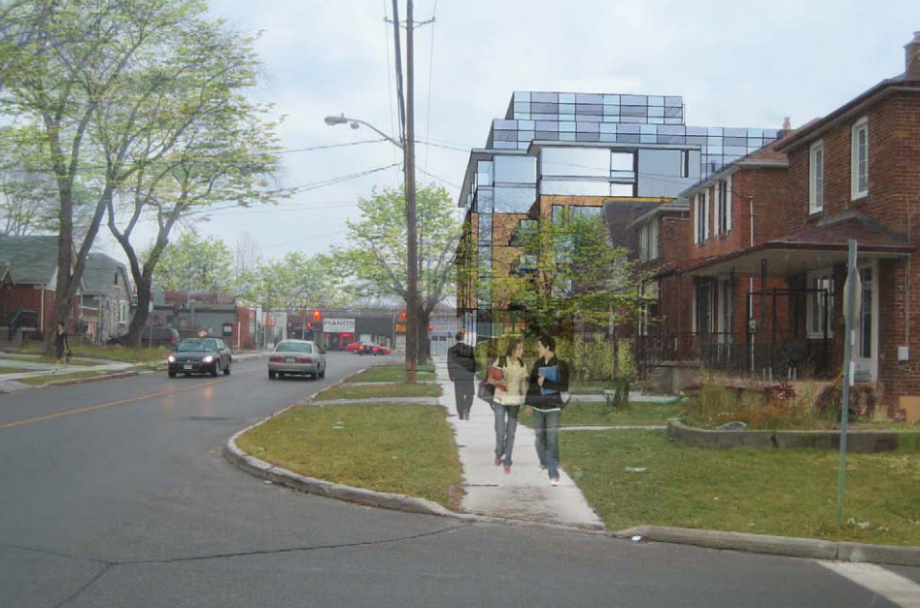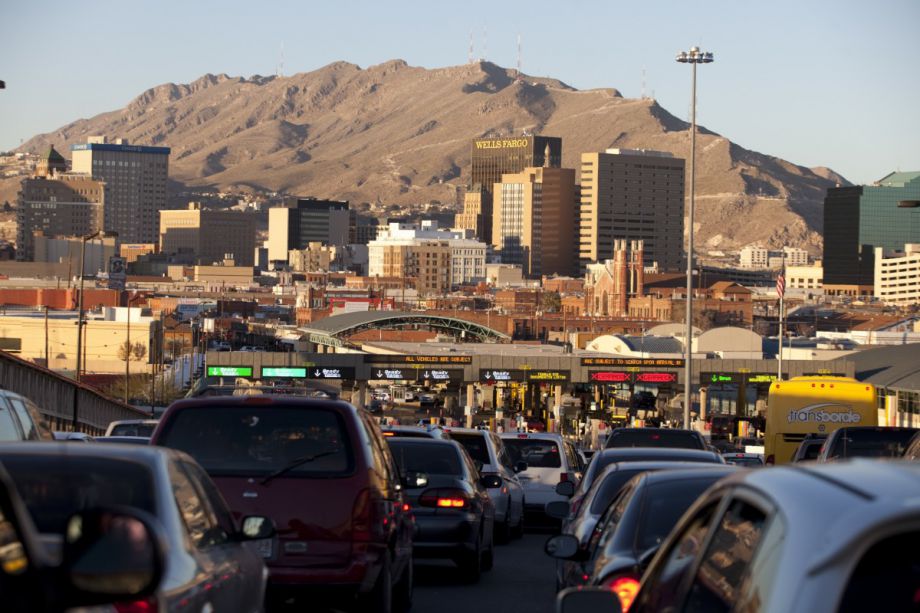Atlanta’s Streetcar Could Have Big Reach, Big Price Tag

This new Atlanta streetcar took its inaugural trip through downtown on Dec. 30, 2014. (AP Photo/David Goldman)
Judging by the media backlash of late, you’d think streetcars were the new Lululemon yoga pants or iPhone Whichever — a Whole Foods version of public transit serving Yuppie developers and tourists more than residents who actually need to get around.
Atlanta, where a 2.7-mile, $98 million streetcar linebegan rolling December 30th, is no stranger to this skepticism.
“Streetcar is cool, but will it be useful?” an Atlanta Journal Constitution op-ed asked in 2013. Its author, transit consultant Jarrett Walker, questioned the line’s small reach (which was then estimated at 1.3 miles) and 15-minute wait time, arguing that if you missed even one for the short route, walking might be faster — an unfortunate situation for workers, parents with children in daycare and basically anyone needing to get somewhere on time.
But though some officials prize streetcars for their ability to foster development over their ability to move people long distances quickly, Atlanta actually does have lofty, expansive (and, no doubt, expensive) plans for its streetcar. If city officials can make good on their stated goals, the streetcar will one day circle the whole city along the outline of an ambitious park, crossing long-entrenched lines of racial segregation, syncing up with MARTA (Atlanta metro’s transit authority), and even helping to reverse the out-commuting patterns of a metro area full of suburban, rather than city-center, jobs. But first they have to pay for it.
Right now, only the vision is clear.
“The next place that the streetcar should go is a stop on the Atlanta BeltLine,” said Mayor Kasim Reed, as reported in the AJC, at the line’s initial launch.
The BeltLine, a rails-to-trails project that will one day run 22 miles around downtown in the shape of a circle, will include park space, public art, walking and biking paths and, eventually, the streetcar line. Its shape, connecting around 45 different neighborhoods, is especially important. As Rebecca Burns detailed for CityLab last year, it will connect areas of historic segregation — intentionally fractured by industrial “buffers” to separate white and black neighborhoods as recently as the ’60s. And because MARTA’s expansion into the white flight suburbs has been halted time and again for blatantly racist reasons, a public transportation system that could actively unite the city is a big deal.
Meanwhile, its current bare-bones system (MARTA only travels north-south and east-west) means that Atlanta has a high percentage of car ownership and terrible traffic. According to Paul Morris, the man at the helm of Atlanta BeltLine Inc., car-centrism and economic inequity go together for the region.
“It will connect 45 neighborhoods for their short-distance daily needs,” he says of the project. “Historically we have not had great connectivity or mobility — we have one of the more challenged mobility environments among the big cities.”
Lee Biola is the chairman of Citizens for Progressive Transit, an organization that supports the streetcar. He, too, sees potential in the ambitious, circular plan.
“One of the problems we’ve long had is that many of the jobs are in the suburbs,” he says. Now, however, he sees shops and restaurants going in on the streetcar line and skyscrapers rising in downtown and midtown. (Someone should tell Mercedes-Benz USA. The automaker announced this week it will move its headquarters from New Jersey to Atlanta, but reportedly, the campus will be in the northern suburbs.)
“Gentrification, for all of its problems, is generating jobs,” he says, adding that having jobs in the urban core, accessible by transit is good for the region’s upward mobility.
“We should not be charging an upfront fee to our economic system,” he adds. “An 18-year-old should not have to pay $5,000 upfront [for a car] just to get to work.”
But, of course, the streetcar will not come free to Atlantans either. Along the BeltLine, rents are rising. And funding for the streetcar is still uncertain.
Morris does outline a plethora of potential sources. Together with state and federal funding, the organization is looking at grants and private-sector fundraising opportunities. The entire BeltLine project has also been reliant on a tax allocation district, a local agreement between the city, county and schools to direct certain property taxes into the BeltLine’s construction. But property taxes took a hit during the recession. And now, Atlanta’s public schools claim that the city, which is overseeing the allocation district, owes them two payments of $6.75 million hinging on that agreement.
Morris declines to comment on negotiations between the city and schools, stating that they’re being handled by Mayor Reed. However, he adds those payment agreements were decided upon before the recession.
“If the original agreement were implemented, it would be devastating to the BeltLine,” he says.
Another snarl comes from the failure of T-SPLOST, a 10-county regional transportation package that would have funded around $8 billion in transit and road projects — including streetcar segments along the BeltLine. Interestingly, the measure would have passed in Atlanta, but failed in surrounding counties, a fractured pattern with which the sprawling metro area is all too familiar.
Still, advocates like Biola are optimistic about the streetcar’s future. Questions may arise on the usefulness of its current small reach, but Biola sees it as just the beginning of a system that could transform Atlanta’s car-centrism and sprawl.
“The line is a great start,” he says of the segment that just opened. “But we hope it’s not the end. We very much think it should be expanded.”
The Works is made possible with the support of the Surdna Foundation.
Rachel Dovey is an award-winning freelance writer and former USC Annenberg fellow living at the northern tip of California’s Bay Area. She writes about infrastructure, water and climate change and has been published by Bust, Wired, Paste, SF Weekly, the East Bay Express and the North Bay Bohemian.
Cities Find Creative Ways to Fund Parks
SPONSORED CONTENT FROM CITY PARKS ALLIANCE

Discovery Green in Houston, where the city has taken a noteworthy approach to parks financing (Photo by David A. Brown Photography)
SPONSORED CONTENT
Even though the benefits of urban parks are widely acknowledged, municipal parks departments around the U.S. must grapple with tight budgets in cash-strapped cities.
In 2008, Philadelphia park officials estimated that the cost of operating the city’s parks was around $30 million per year, according to a paper by the Trust for Public Land. Philadelphia Parks and Recreation currently has an operating budget of $51.8 million, a figure that still leaves local advocates clamoring for more. “It’s foolhardy and short-sighted not to give this department what it deserves,” said Philadelphia Parks Alliance Executive Director Lauren Bornfriend last year.
The good news is that innovative park officials and advocates are thinking creatively and forging new ways to fund city parks.
In August, Seattle saw the landmark passage of Proposition 1, which established an independent Seattle Parks District with taxing authority.
“Really it was a city stepping up to levy taxes on an ongoing basis through a state-sanctioned mechanism,” says Thatcher Bailey, executive director at the Seattle Parks Foundation. The idea of a metropolitan parks district in Seattle had been long gestating, but it gained more support on the part of local parks advocates after the Seattle Parks Foundation led a study in 2012 on alternative funding options. The study argued that a new parks district would “reduce the strain on future city budgets.”
“The campaign was much more grueling than any of us anticipated,” says Bailey, referring to the tense debate over the ballot measure, with critics anxious that removing the need to renew parks funding by vote might be undemocratic. Still, Proposition 1 passed 53 to 47 percent.
Seattle now has a chance to back its green spaces with a source of unfettered funds and even catch up on a maintenance backlog. Bailey is careful to note that a metropolitan parks district may not be the solution for every city. It’s up to local parks champions to hammer out the funding models that work legislatively for them. The security of undiverted funds may be universally attractive though.
“Oftentimes when cuts need to be made, it’s hard for jurisdictions to justify making sure the ball fields get mowed when you have to make cuts to police and fire. It’s always going to be a tough political call. I think protecting the funding of the parks [matters], because in bad times, they’re even more important,” says Bailey.
Houston also has a noteworthy approach to parks financing. A 2007 statute completely changed how the city’s parks were organized. Houston’s Open Space Ordinance organized the city’s 656 square miles (for comparison, that’s larger than the five boroughs of New York City) into park sectors. It requires developers to include private or public parkland in their plans or submit a fee that goes into the park fund, and can only be spent within the same sector.
Since the 2008 fiscal year, fees paid by developers under the ordinance have totaled more than $17 million. From 2009, 21.5 acres of private parks and one acre of public parks have been created through new development, according to Houston Parks and Recreation.
“It’s one of the tools we’re using to turn our city green,” says Houston Parks Director Joe Turner. “It’s not the answer to everything because if you’re not developing in a sector, it’s not going to create sector monies. That means in our master plan process, those areas that aren’t seeing development [should be the focus] of our bond money, so every citizen has access to a park in a 10-minute or roughly half-mile radius.”
There are currently 21 sectors, which will each have their own master plan come next spring, says Turner. The department is consulting the Trust for Public Land’s ParkScore system to inform them of which neighborhoods need city funds the most.
Turner says the department is also working with colleagues in the planning department and researchers at Rice University to consider which new sites will be best with respect to population trends, equity and public health benefits.
“It’s not a simple issue, but it’s a simple goal,” says Turner.
City Parks Alliance is the only independent, nationwide membership organization solely dedicated to urban parks. It unites and serves a growing network of hundreds of civic and community leaders, government agencies, parks and recreation authorities, funders and others. To join the global urban parks community at CPA’s biennial Greater & Greener conference in San Francisco in April, go here to register.
Can Taller Buildings Make Toronto More Affordable?

A rendering from the City of Toronto’s “Avenues and Mid-Rise Buildings Plan” (Credit: Brook McIlroy Planning & Urban Design)
A two-story-high change in Ontario’s building code could help to increase density and ease affordable housing strains in the city of Toronto. As of January 1st, developers can now construct wood-frame buildings up to six stories; the previous height limit was four stories.
The booming Canadian city has been struggling to integrate its dual needs of housing and transit, and this change could certainly help with the first. In 2010, the planning department put forth its Avenues and Mid-Rise Buildings Plan, which called for the development of five- to 10-story multi-use buildings along arterial streets.
“What the city had been looking for was a gentler way of intensification along these avenues,” says Lorna Day, from Toronto’s planning department. “They form the edges of our neighborhoods as well as a frontage to our transit system.”
Sites once considered too narrow are now open for consideration for redevelopment now that they can accommodate taller, income-generating properties. “What this will do will make redevelopers look at these smaller lots and realize that they don’t need a 100-foot frontage on a corner in order to make redevelopment more feasible,” says Day.
Advances in wood-frame construction allow more ambitious heights while still maintaining fire and structural safety, and Day notes that wood, as a material, is cheaper. Additionally, this type of construction is more flexible than steel and concrete. Walls, stairwells and even elevator shafts can be pre-fabricated off site and then erected relatively quickly on site — an advantageous efficiency when it comes to putting together financing packages that fund developments.
Some experts say that this type of construction could be up to 20 percent less costly to produce, and these savings could be passed on to renters. Nonetheless, Day is cautious about making promises.
“It’s a crystal ball question about whether this will ease [affordability concerns],” she says. “I don’t foresee this change happening overnight. I think that this is something that the industry needs to test for a while. If you delve into the details of the code, it’s still pretty restrictive. You’re not going to get big buildings out of this. But, my understanding is that this form of housing could be more affordable on a cost per square footage basis.”
Fire officials are uncommon partners in planning conversations, but they worked closely with Toronto and Ontario planners and building officials to make sure that the code change guaranteed safety, as well as supported the city’s other planning initiatives. Another surprising stakeholder in the mix is Ontario’s forestry and wood industry, which sees the move as a boost to Northern Ontario’s economy.
The subtle change might not see much in terms of immediate results, but it’s just one of the ways that Toronto’s planning department is pushing the envelope.
“From a buildings perspective, this is the loosening of one screw to help this initiative of getting more housing on our avenues,” says Day.
The Equity Factor is made possible with the support of the Surdna Foundation.

Alexis Stephens is Next City’s urban economics fellow. She’s written about housing, pop culture, global music subcultures, and more for publications like Shelterforce,Rolling Stone, SPIN, and MTV Iggy. She has a B.A. in urban studies from Barnard College and an M.S. in historic preservation from the University of Pennsylvania.
Obama’s Pledge Could Make It Easier to Walk Across U.S.-Mexico Border

Vehicles line up to cross the Paso del Norte Bridge between El Paso, Texas and Ciudad Juarez in Mexico. (AP Photo/Ivan Pierre Aguirre)
Rush hour on the Paso del Norte International Bridge is similar to urban river crossings everywhere. Cars crawl in traffic while pedestrians and bikes briskly traverse. But there’s one major difference for those commuters: They all need a passport. The bustling pedestrian link over the Rio Grande, between El Paso, Texas and neighboring Ciudad Juarez in Mexico is arguably the most urban along the Southern Border.
While 7.7 million annual pedestrian entries from Tijuana make San Ysidro the busiest U.S.-Mexico port of entry for walkers, the U.S. side of that crossing is a suburban area of San Diego. Paso del Norte, the second busiest pedestrian border crossing with six million entries annually, empties into El Paso’s downtown.
The Texas city and its larger Mexican neighbor (population 1.5 million) have a unique symbiosis.
“For every maquila [factory] in Juarez, one to four jobs are created in El Paso,” says Paul Stresow, El Paso’s director of international bridges. “Mexican customers account for 15 percent of the shopping here.” While some head to the malls and box stores of El Paso’s urban sprawl, crossing at the highway-sized Bridge of the Americas downriver, many merchants depend on Paso del Norte foot traffic.
“Downtown commerce is critically important and disruption at the border hurts bottom lines,” says Garrick Taylor, policy director of the Border Trade Alliance.
Along El Paso Street at the foot of the bridge, storefronts blaring banda music sport signs advertising shoes, jeans, perfume, cell phones and clothes, all goods that fetch lower prices in the U.S.
As Juarez cartel violence recedes, the twin cities have resumed the circulation that makes this 2.7-million metro area the largest bilingual, binational workforce in the Western Hemisphere, especially since the 1994 NAFTA agreement that liberalized trade relations between the neighboring countries. But the line on a map drawn by the 1848 Treaty of Guadalupe Hidalgo complicates matters, with a patchwork overlap of federal and local authorities split between two countries and two cities responsible for maintaining public infrastructure at the border.
Originally built as the flat-span Santa Fe Bridge in 1881, the site where downtown El Paso meets downtown Juarez has been a border crossing for at least 250 years, according to Stresow. It was reconstructed in 1967 as an arching span and hosted international bus service until 1973, with international streetcar service stopping a year later.
As El Paso embarks on BRT and contemplates reviving its streetcar network, Ciudad Juarez is implementing the Plan de Movilidad Urbana to repave its battered streets. Reviving transit at the Paso del Norte would be a prime opportunity to improve downtown linkages. No proposal is on the table presently, although Stresow is in favor. “It’s something that needs to be studied and planned for in order to anticipate the future,” he says.
Currently the bridge serves northbound non-commercial traffic — vehicles heading into the U.S. — which means lots of idling cars waiting for Customs and Border Patrol (CBP). Once upon a time crossing was a fluid experience, no worse than a toll plaza (which remains, charging pedestrians a small fare and cars a higher one). That changed after September 11, 2001: Security was beefed up, and now long border waits sometimes stretch to hours at peak times.
“It’s like Mexicans committed 9/11,” gripes Maria Teresa Vásquez, a Mexican citizen who commutes daily from her home in El Paso to the Autonomous University of Ciudad Juarez, where she researches binational planning. “El Paso is a suburb of Ciudad Juarez,” she claims provocatively, citing the population discrepancy, “But decisions are mostly made on the other [U.S.] side.”
When I was at the bridge during a rush hour last October, crossing in a car took nearly an hour and every vehicle left its engine running, which created nauseating fumes for pedestrians and especially vendors who weaved between idling cars selling snacks and gums.
Yahír Ramirez, who said he was a Central American immigrant deported to Juarez, sells pirate CDs to make ends meet. The backups are good for business, but, he said, “there are accidents with the cars, we have to pay attention because it’s dangerous. Every now and then the police come up and give us trouble, pushing us back onto the Mexican side.”
Agapita Perez lives in Juarez but visits her mother in El Paso three times a week with her young daughter. “I wish they had a priority lane for strollers and seniors,” she said. Stresow concedes that the bridge is not ADA-compliant despite 2009 renovations that provided shade canopies for pedestrians and redesigned the entry plaza on the U.S. side.
For its part, CBP has implemented several measures to ease crossing pains. It has partnered with the EPA to evaluate strategies for “greening” the bridges. Wait times are available online, and last month the agency launched a smartphone app with real-time updates. In the 1990s, CBP implemented SENTRI, a program that provides expedited crossing for low-risk travelers.
“The SENTRI lane is almost always empty despite our repeated efforts to get pedestrian border crossers to enroll, especially those who cross multiple times a week,” says Roger Maier, a public affairs specialist at CBP. “Nevertheless this option is consistently underutilized.”
For low-income Juarenses, smartphones and the $122 SENTRI entry fee may be cost prohibitive.
Public health researchers are increasingly concerned about air quality in border communities, especially as NAFTA increased the amount of truck traffic. Hector Olivera, research assistant professor at the University of Texas at El Paso, has studied the nano particles emitted by commercial vehicles crossing the Bridge of the Americas. As for Paso del Norte, which he has not researched specifically, he says, “There’s enough evidence to at least prompt studies. People are exposed at the bridge to consistently high concentrations and they merit that government and academia verify if it’s dangerous.”
If NAFTA helped engender the problem, however, it may also provide a solution. The trade agreement chartered the North American Development Bank (NADB) to fund projects along the border, with air quality a focus area. “We fund road projects under the guise of air quality improvements,” explains Juan Antonio Flores, NADB’s associate director of public affairs. “Unpaved streets are the biggest cause of particulate matter in Mexican border communities.”
NADB lent Ciudad Juarez $30 million for its ongoing urban mobility plan, for example, and could conceivably play a role in future efforts to improve linkages across Paso del Norte, which would be a prime candidate for the all multi-modal no-cars treatment à la Portland’s Tilikum Crossing. As an institution that straddles the border, NADB works with both the U.S. federal government, where the General Services Administration has traditionally funded border infrastructure with some local involvement, and the Mexican government, which allows private concessionaires.
Flores calls the Mexican approach “more progressive” but adds, “a recent U.S. law allows for public-private partnerships and cost-sharing for staffing at ports of entry because of fiscal constraints at the federal level. The old way of doing things, where the federal government paid for everything, doesn’t work anymore.”
The City of El Paso has already taken advantage of cost-sharing by paying CBP to keep extra lanes open and ease backups. NADB, meanwhile, will receive a $3 billion cash injection from this week’s bilateral negotiation in Washington between President Barack Obama and Mexican President Enrique Peña Nieto.
For the daily crossers at Paso del Norte, any improvements will be a welcome relief.
The Works is made possible with the support of the Surdna Foundation.

Gregory Scruggs writes about cities and culture, especially in Latin America and the Caribbean.



No comments:
Post a Comment
Please leave a comment-- or suggestions, particularly of topics and places you'd like to see covered